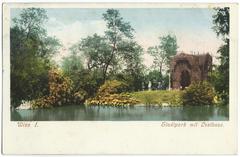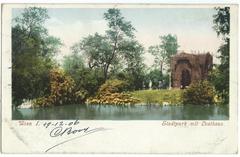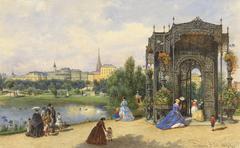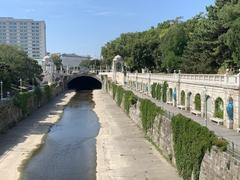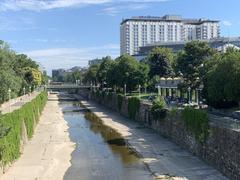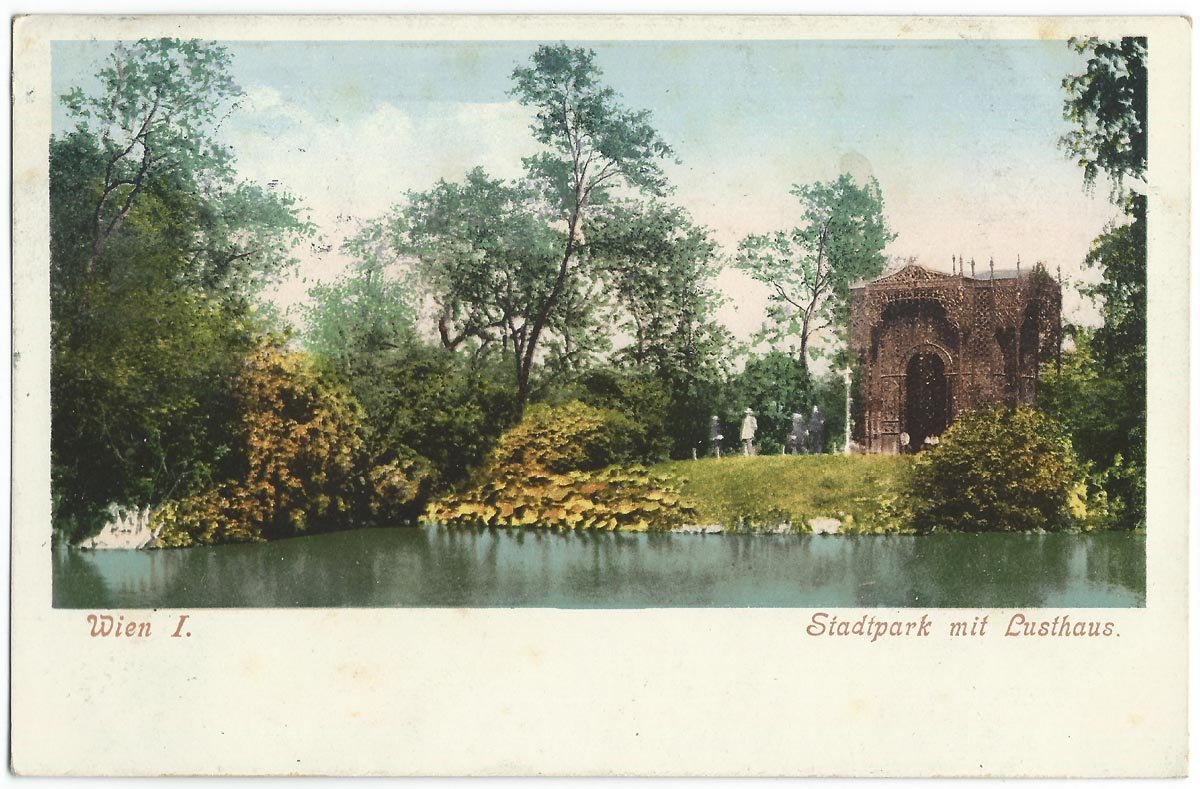
Stadtpark Vienna Visiting Hours, Tickets, and Attractions Guide
Date: 14/06/2025
Introduction to Stadtpark Vienna
Stadtpark, Vienna’s first and most celebrated public park, is an essential destination for anyone eager to experience the city’s harmonious blend of nature, history, and culture. Established in 1862 during the city’s transformation with the construction of the Ringstraße, Stadtpark was envisioned as a democratic green oasis for all citizens (vienna-trips.at; wien.gv.at). Spanning over 65,000 square meters and divided by the Wien River, the park features English landscape garden design, winding paths, scenic vistas, and an array of seasonal plantings.
But Stadtpark is more than a botanical haven; it serves as an open-air gallery of Vienna’s illustrious musical and artistic history. Its most famous landmark, the gilded statue of Johann Strauss II, draws thousands of visitors annually and is joined by tributes to other musical greats such as Franz Schubert and Franz Lehár (vienna-trips.at; introducingvienna.com). The elegant Kursalon concert hall, built in the Italian Renaissance style, remains a vibrant venue for classical concerts and social events (kursalon.at).
Open year-round with free admission and easily accessible via Vienna’s extensive public transport network, Stadtpark invites visitors to explore its historic pavilions, Art Nouveau architecture, family-friendly spaces, and annual cultural festivals. Whether you are interested in leisurely strolls, musical heritage, historical monuments, or community events, Stadtpark encapsulates Vienna’s identity as a city of parks, music, and culture (wien.gv.at; visitingvienna.com).
Table of Contents
- Origins and Early Development
- Expansion and Architectural Highlights
- Botanical and Artistic Features
- Cultural Significance and Social Role
- Notable Historical Events and Figures
- Stadtpark Vienna Visiting Hours, Tickets, and Accessibility
- Travel Tips for Visiting Stadtpark Vienna
- Frequently Asked Questions (FAQ)
- Visual Highlights
- Related Articles
- Conclusion and Call to Action
Origins and Early Development
Stadtpark emerged during a period of profound urban renewal in Vienna. The city council, recognizing the need for accessible green spaces amid rapid population growth, selected the land along the left bank of the Wien River for the new park in the early 1860s (vienna-trips.at). Court painter Joseph Selleny designed the park in the English landscape style, emphasizing alternating groves and meadows, romantic winding paths, and ornamental plantings. City gardener Rudolf Siebeck oversaw the implementation, ensuring the vision of an “artificial landscape in the city” was brought to life (wien.gv.at).
Stadtpark officially opened to the public on August 21, 1862, as Vienna’s first communal park accessible to all, symbolizing a new era in urban planning and public welfare (vienna-trips.at).
Expansion and Architectural Highlights
The park’s development continued rapidly after its opening. In 1862, a cast-iron pavilion from the London World Exhibition was installed, and by 1863, a dedicated children’s playground had been established on the right bank of the Wien River (wien.gv.at). The iconic Kursalon concert hall, completed in 1867 and designed in the Italian Renaissance style, quickly became the epicenter of social life, hosting dances, concerts, and gatherings (allaboutvienna.com).
Bridges were built across the Wien River, connecting the park’s two halves and enhancing accessibility. In 1906, Art Nouveau architects Friedrich Ohmann and Josef Hackhofer oversaw the covering of the river and the creation of a promenade, further integrating the park into Vienna’s urban fabric (wien.gv.at).
Botanical and Artistic Features
Stadtpark was designed for year-round visual interest, with ornamental shrubs, flowering plants, and a diverse array of trees providing seasonal color and variety (wien.gv.at). The romantic landscape is punctuated by a remarkable collection of monuments and sculptures honoring Vienna’s cultural luminaries.
The gilded bronze statue of Johann Strauss II, unveiled in 1921, is the park’s centerpiece and one of Vienna’s most photographed sites (vienna-trips.at). Sculpted by Edmund Hellmer, it is regularly restored to preserve its brilliance. Additional monuments throughout the park celebrate composers such as Franz Schubert, Franz Lehár, and Robert Stolz, as well as artists like Hans Makart, making Stadtpark a true open-air gallery (vienna-trips.at).
Cultural Significance and Social Role
As Vienna’s first public park, Stadtpark set a precedent for the city’s many green spaces and contributed greatly to its reputation as a city of parks and gardens (theviennablog.com). Its central location, spanning the border between the 1st and 3rd districts, made it a natural gathering place for locals and visitors alike. The Kursalon’s ongoing tradition of concerts and social events has made Stadtpark a cultural hotspot for over a century (allaboutvienna.com).
Today, the park continues to host major events such as the annual Genussfestival, which showcases Austrian regional cuisine and attracts thousands each May (vienna-trips.at). Stadtpark’s enduring popularity reflects its success as a space for leisure, cultural enrichment, and vibrant community life.
Notable Historical Events and Figures
Stadtpark’s legacy is deeply intertwined with Vienna’s musical and cultural history. The park’s most famous figure, Johann Strauss II, not only inspired the iconic statue but also performed at the Kursalon, reinforcing the park’s association with Vienna’s musical tradition (vienna-trips.at). Monuments to Franz Schubert, Franz Lehár, and Robert Stolz further highlight this legacy (visitingvienna.com).
Significant milestones include the park’s opening in 1862—which coincided with the establishment of Vienna’s Municipal Department for Parks and Gardens—and the public unveiling of the Strauss monument in 1921, a major cultural event (wien.gv.at).
Stadtpark Vienna Visiting Hours, Tickets, and Accessibility
Stadtpark is open 24 hours a day, 7 days a week, offering unrestricted access to its grounds (city-walks.info; wien.gv.at). Entry is free of charge; no ticket is required. Concerts and events at the Kursalon require separate tickets, which can be purchased online or at the venue (kursalon.at).
The park is centrally located and easily accessible by public transport:
- U-Bahn: U4 (Stadtpark station), U3 (Stubentor station)
- Tram: Lines 1, 2, 71
- Bus: Several lines stop nearby
Stadtpark is wheelchair and stroller friendly, with paved, level paths and accessible restrooms. Benches, drinking fountains, and picnic areas are distributed throughout the park.
Travel Tips for Visiting Stadtpark Vienna
- Visit at Golden Hour: Arrive in early morning or late afternoon for soft light and fewer crowds, especially if you want to photograph the Johann Strauss II monument.
- Check the Events Calendar: The Kursalon hosts year-round classical concerts and events. Advance tickets are recommended (kursalon.at).
- Enjoy a Picnic: Bring a blanket and snacks to enjoy the lawns or riverside areas.
- Combine with Other Attractions: Stadtpark is within walking distance of the Museum of Applied Arts (MAK), the Vienna State Opera, and the Ringstraße.
- Seasonal Highlights: Spring and summer feature vibrant flowerbeds; autumn showcases beautiful foliage; winter offers peaceful strolls and atmospheric views.
Frequently Asked Questions (FAQ)
Q: What are Stadtpark’s opening hours?
A: Stadtpark is open 24/7, year-round.
Q: Is there an entrance fee?
A: No, entry to Stadtpark is free.
Q: How do I get there by public transport?
A: Use U4 (Stadtpark station), U3 (Stubentor), or nearby tram/bus lines.
Q: Are guided tours available?
A: Yes, several Vienna city tours include Stadtpark as a highlight. Check with local tour operators for schedules.
Q: Is Stadtpark family-friendly?
A: Yes, the park features playgrounds, open meadows, and a duck pond—perfect for families.
Q: Are dogs allowed?
A: Dogs are not permitted in the main park but can be walked along the river promenade.
Visual Highlights
- Johann Strauss II Statue: The park’s gilded, world-famous monument.
- Kursalon Wien: A grand concert hall and cultural hub.
- Floral Clock: A functional clock covered in seasonal flowers.
- Jugendstil Bridges: Art Nouveau bridges over the Vienna River.
- Historic Pavilions: Picturesque shelters and gazebos.
For virtual tours and interactive maps, see Vienna Info.
Related Articles
- A Guide to Vienna’s Ringstraße: History and Highlights
- Top 10 Historical Sites in Vienna
- Vienna Concert Venues: Where to Experience Classical Music
Conclusion and Call to Action
Stadtpark Vienna is a living embodiment of the city’s artistic, historical, and natural riches. Open around the clock and free to all, the park offers a tranquil retreat, a gallery of musical monuments, and a vibrant venue for cultural events. Whether you’re enjoying a classical concert at the Kursalon, photographing the Strauss monument, or simply relaxing by the river, Stadtpark is a must-visit highlight for every Vienna traveler.
For audio guides, event updates, and curated walking tours, download the Audiala app and follow us on social media. Explore more Vienna historical sites through our platform, and make Stadtpark a centerpiece of your Vienna adventure.
References and Further Reading
- Stadtpark Vienna: Visiting Hours, Tickets, History, and Travel Tips
- Stadtpark Vienna: Cultural Significance and Visitor Information
- Kursalon Official Website
- Stadtpark Vienna: Visiting Hours, Tickets, and Guide
- Stadtpark Vienna Visitor Info
- Stadtpark Vienna: Historical and Cultural Overview
- Stadtpark Vienna Sightseeing Guide
- Vienna City Parks and Gardens
